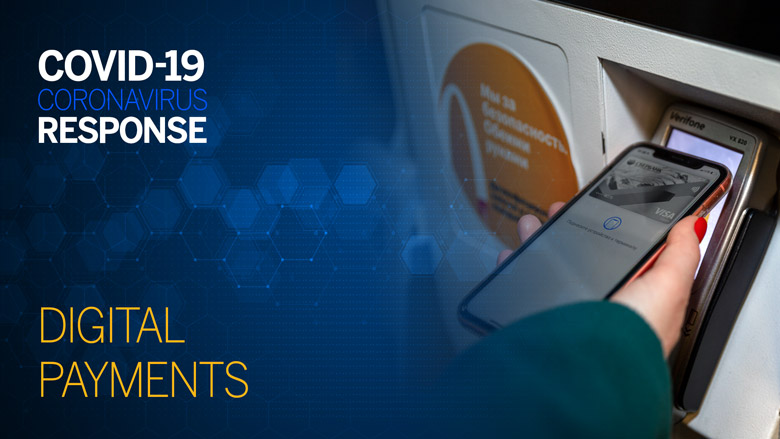
CHALLENGES
The COVID-19 pandemic has led to an increased demand for the use of digitally enabled services by individuals, businesses, and governments. Yet the speed, cost, and efficiency of these services largely depend on a country’s digital infrastructure.
Since the beginning of the recent crisis, all sectors of society have been increasingly relying on digitally enabled services to purchase goods and services, make payments, and distribute social and emergency assistance as person-to-person contact has become limited. The feasibility of this effort, however, depends on how a country’s digital infrastructure, including its payment systems, have been leveraged to meet the needs of households and online businesses and deliver financial assistance to the most vulnerable.
Social distancing requirements and the general restrictions on physical movement have created an unprecedented demand for digital payment systems.
Financial sector authorities and banks in many countries, while working to maintain the supply of currency notes and coins, have urged consumers and businesses to use digital payments. The COVID-19 pandemic has therefore made plain the value of technologies that enable an economy to operate at arm’s length and partially overcome social distancing, thereby mitigating the economic and social impact of the crisis. For example, digital payments can better facilitate the rapid, targeted, and cost-effective disbursement of cash transfers to support affected households and firms than physical cash.
The COVID-19 pandemic could materially impact payment services that are extensively used by individuals, businesses, and governments.
The pandemic has highlighted the value of having access to diverse means of payments—and the need for these payment methods to be resilient to a broad range of threats. For example, the current crisis has led to unprecedented public concerns about viral transmission through cash money. Central banks report a large increase in inquiries from the media on the safety of using cash, concerns that are not, it should be noted, necessarily valid, as the World Health Organization recently issued a press release to clarify that the risk of COVID-19 transmission through currency notes and coins is low.
Drastic changes in work and consumption patterns, such as the dramatic shift to online shopping, will likely have a lasting impact on economic relationships and the use of digital financial services.
For example, card payments may get a boost from the COVID-19 crisis. Other economic and societal effects will depend on the actual extent to which individuals adopt each non-cash payment service, something that is likely to vary by geographic region, urban versus rural residency, and so forth. Yet even in those countries with a high usage of digital financial services, there are nevertheless some individuals who have been slow to use this technology, including the elderly and inhabitants of smaller cities or rural areas.
WHAT RUSSIA HAS DONE TO CONFRONT THESE CHALLENGES
The use of digital payments in Russia has been on the rise in recent years. According to the World Bank 2018 Global Findex database, 70 percent of the adult population in Russia—fully 93 percent of account owners—make or receive digital payments as they utilize their accounts. This is considered to be a high percentage, relative not only to all account users but also to the share of the adult population who use digital payments among most upper-middle-income countries (64 percent) and to Malaysia and China (with levels also at around 70 percent). Thus, in Russia, where digital payments are already common, COVID-19 could be a significant driver of even greater use of digital financial services.
- The Russian authorities have urged consumers and businesses to use digital payments rather than cash to slow down the spread of the coronavirus and advised commercial banks to limit the number of ruble notes in circulation.
- The Central Bank of Russia has endorsed the following measures:
- Lowering/waiving the fees on instant payments using the Central Bank of Russia’s Fast Payment System.
- Lowering the fees paid by online merchants for the acceptance of cards to encourage the use of online purchases for essential goods and services.
- Allowing banks an automatic extension of all bank cards approaching their expiration date through July 1, 2020
- Temporarily allowing banks (during the quarantine period) to open accounts remotely with simplified know-your-customer (KYC) rules, provided these accounts are opened by individuals to make or receive socially important payments (social transfers, alimony, insurance reimbursements, mortgage payments, etc.) or by small and medium enterprises (SMEs) to receive grants/loans to preserve jobs and ensure salary payments to employees.
WHAT MORE COULD BE DONE?
Enhanced monitoring of increased cybersecurity risks and AML/CFT concerns
In terms of the immediate COVID-19-related response, the increased use of digital payments and other financial services, including due to the temporary relaxation of KYC requirements and increased transaction limits, should be balanced against the careful monitoring of intensified cybersecurity risks and concerns about anti-money laundering and combating the financing of terrorism (AML/CFT).
Accelerated use of biometric data and digital IDs for individuals and SMEs
In the medium term, accelerating the use of biometric data and digital IDs for both individuals and SMEs to facilitate remote customer identification and enrollment would lead to a greater adoption of digital financial services.
WHAT ARE OTHER COUNTRIES DOING?
Adopting policy measures to encourage a shift to digital payments and facilitate government-to-person payments
As of mid-April 2020, the World Bank had catalogued 53 policy measures implemented in 35 countries to support the smooth functioning of national payment systems and facilitate the use of digital payments in response to the COVID-19 crisis. Broadly, they can be grouped around the following categories:
- reduction or waiver of fees on some critical payment services
- temporary increase in the limits to conducting various financial transactions (cash withdrawals, contactless payments, etc.)
- promotion of the methods available for digital payments, including for channeling government assistance, etc.
Recently, authorities, banks, and card networks in Austria, Germany, Hungary, Ireland, the Netherlands, Spain, and the United Kingdom have set higher transaction limits for contactless payments. Digital wallets or other smartphone-based payment interfaces (such as stored card details or QR codes), where no physical contact of the same object by multiple persons takes place, are other potential solutions.
Leveraging digital identity systems to enhance crisis response and social support
Jurisdictions that have established retail payment and digital identity systems are already leveraging them to enhance their crisis response. For example, Cuenta Rut, an ID-linked basic account in Chile, will allow 2 million vulnerable Chileans to benefit from COVID-related support by receiving government emergency payments into their bank accounts.
In India, over 80 percent of adults have a bank account and roughly 80 percent of the country’s nearly 1 billion bank accounts are linked to Aadhaar, a biometric ID system. This has enabled the government to shift to digital transfers for many benefit programs, from social assistance payments to food subsidies. In addition to these existing programs, India can use this infrastructure immediately to distribute payments to all Aadhaar-linked accounts as part of the COVID-19 response.
RISKS AND PITFALLS TO AVOID
It is important to build strong institutional, legal, and technical safeguards for data protection, privacy, and security as digitalization accelerates.
It should also be noted that cybersecurity risks (such as cyber fraud) could be heightened due to the increased use of online and other digital payments, including by first-time users, and the potential relaxation of some risk management measures in the context of the crisis. Financial institutions and retailers must prepare to constantly adjust fraud controls against changing consumer behavior. In a survey of 1,068 U.S. adults, TransUnion found that 22 percent had been targeted by digital fraud related to the coronavirus, while the number of active phishing sites skyrocketed from 149,000 in January to more than 500,000 in mid-March, according to a new report from Atlas VPN.
It is important to make sure that new limits for increased transactions should not create AML/CFT concerns.
A number of countries have temporarily increased transaction and balance limits, especially for those account/payment products that are used by the population more vulnerable to COVID-19. However, it is essential to ensure that the new limits do not create AML/CFT concerns, particularly for accounts opened through simplified customer due diligence procedures.
It is important to be conscious of greater digital divides across society.
In many of the emerging market and developing economies where authorities have recently called for the greater use of digital payments, access to these alternatives is not universal. This means that some segments of the population may not have the means to use them, which could lead to an even greater digital divide as an unintended consequence. Further information on this topic can be found in the April 2020 World Bank report, “Payment Aspects of Financial Inclusion in the Fintech Era,” published by the Bank for International Settlements and World Bank Group
Last Updated: May 05, 2020
MULTIMEDIA
Expert Answers: How Can We Help Countries Dealing with Coronavirus?
Experts
Renaud Seligmann
Director for Strategy and Operations, Planet Vice Presidency
Boutheina Guermazi
Director, Strategy and Operations, Middle East & North Africa, Afghanistan & Pakistan (MENAAP)

